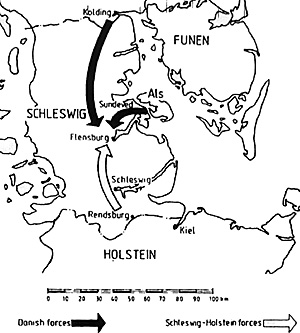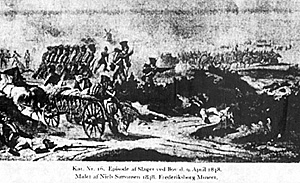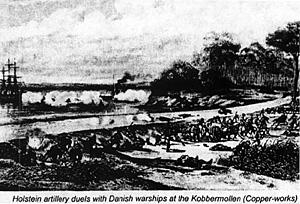If you wargame the 1864 Prusso-Danish War but have run out of historical battles to re-fight, then the first Schleswig-Holstein War has plenty to offer. You can basically use the same figures. The best part is the Danish Army was better in 1848 compared to 1864 and actually won the war.
 Historical Background
Historical Background
The First Schleswig-Holstein war was one of several rebellions and civil wars that erupted in Europe in 1848. The reasons for the war are complicated and go back to the 1300's. The duchies of Schleswig-Holstein were German speaking but were under Danish control.
In the 1830's, feelings started getting stronger over this issue. King Christian VIII of Denmark tried initiatives in 1840 (Language Rescript) and 1844 (Language Patent) to appease both sides but achieved little In 1846, the King declared the act of Succession to the Crown was in full force for the Duchies of Schleswig and large parts of Holstein.
On March 20, 1848, word reached Denmark that a meeting was held in Rendsburg in the disputed area a few days earlier. Schleswig and Holstein had decided to send a deputation to the Danish King with the demands of a free constitution, the union of Schleswig with Holstein and the incorporation of Schleswig into the German Federation.
One of the Danish liberal Politicians, Orla Lehmann decided to state that a revolt had broken out in the Duchies. Lehmann along with other liberals later that evening declared that the Danish King should dismiss all of his ministers and appoint new ones who could save Denmark.
The next day, roughly 20,000 people gathered and proceeded to Christiansborg, the Danish governmental seat and demanded a new government. The King then dismissed his old ministers. Word then reached Schleswig and Holstein on March 24th that a revolution had broken out in Denmark.
The Duchies then formed a provisional government on March 24 with its capital in Kiel. They decided that Denmark was preparing to attack the Duchies so later that day, the Prince of Nor seized the fortress of Rendsburg with the 5th Corps of Chaussers and fifty men of the civic guard. The war had formally started.
During the next few days, the other garrisons in the Duchies changed sides to support of Schleswig-Holstein. Most of the NCO's in the Duchies stayed with their units and fought with them. 65 officers went over to the Schleswig-Holstein side while 94 remained loyal to Denmark. Roughly a fourth of the Danish Army also went over to the insurgents.
The Danes decided to advance South with the main force of the army (the Norrejyske Armeekorps) from Kolding and under command of Hedemann. A small force (the Flankekorpset) under Colonel Schleppegrell was to move from the island of Alsen through Sundeved and join the main force. The main army had 7,200 men while the flanking force had 3,800 men. See map 1 above for the strategic situation.
Schleswig-Holstein realized they were going be outnumbered. On March 27th, they called for men to form free corps. 1000 men volunteered but later, these groups were disbanded because they were too much trouble. On April 8th, the Duchies army totaled 6,150 men.
 The Duchies decided that the army should advance North to gain respect. Colonel Krohn in early April disposed army units in terrain North of Flensborg, at the village of Bov and along the stream of Krusau. This stream flows into Flensborg fjord.
The Duchies decided that the army should advance North to gain respect. Colonel Krohn in early April disposed army units in terrain North of Flensborg, at the village of Bov and along the stream of Krusau. This stream flows into Flensborg fjord.
Meanwhile, the Danes under command of General Hedemann on April 6 had landed an infantry battalion on the peninsula of Holnis in Flensborger Fjord. Colonel Krohn felt threatened and repsonded by sending three battalions and a free corps to Glucksburg to stop a possible Danish flank attack. This force was roughly a third of the Schleswig-Holstein army.
The Danish plan was to hold the Schleswig-Holstein defensive line while cavalry and infantry units were to go around Bov to the West, advance to Flensborg and block the retreat of the enemy. The Danes hoped to crush the rebellion quickly.
On the morning of April 9th, the Danes started their offensive. The advance guard under Lieutenant Colonel Magius was ordered to take Bov. Major Michelsen defended Bov with a corps of Chasseurs, some infantry companies and some students. The Danish advance guard had two squadrons of Guard Hussars, the first Squadron of the 4th Dragoons Regiment, the 12th line battalion, the 3rd Jagers and a 6 lb. Artillery battery. Supporting the assault was Colonel Schleppergrell with an artillery battery, 1st Jagers, 10th line battalion and a cavalry squadron.
Following the advance guard was the 1st Brigade under Colonel Bulow (1st, 2nd and 11th line battalions) with the 2nd brigade (4th and 7th line battalions). Lieutenant Colonel Haxthaussen with the 5th Jagers and two guns were ordered to attack the copper factory at Krussau which is East of Bov. General Wedel-Wedelsborg with the 3rd and 6th dragoons and a medium artillery battery was to advance East of Bov and pursue any routing units.
The Jagers led the assault and started by attacking the church at Bov. Meanwhile, an infantry company went in from south of Bov but was met by crossfire from Duchy troops who were behind hedges and in the houses. Two guns were setup and ordered to breach the Duchy barricades.
Bov was taken after a hard struggle in which the Danes poured on artillery fire. The Schleswig-Holstein troops retreated South to Nyhus. The Danish advance guard remained in Bov while the Danish 1st brigade was ordered to attack Nyhus with the 2nd brigade in support.
The Schleswig-Holsteiners retreated further south to Harriselv. The Danish 1st and 11th line battalions from the 1st brigade attacked the eastern part while the 2nd battalion assaulted from the south. Meanwhile, Colonel Schleppergrell had started to move against Harreslev with the 1st Jagers, 10th line battalion and a cavalry squadron.
The Schleswig-Holsteiner troops retreated from Harreslev after a hard fight toward Flensborg. They situated themselves in the woods and fields north of town. The Danish 6th Dragoons attempted to pursue them but the Duchy troops had retreated too quickly. The Danish 1st brigade then started attacking Flensborg. Severe fighting took place at the two mills located North of town. The Duchy infantry stubbornly defended the mills but the Danish 2nd battalion took the positions.
 As this took place, Danish Lieutenant Colonel Rye with the 1st line battalion moved toward Mariegaard to cut off the Duchy retreat from Flensborg. However, the Duchy troops defended the buildings of the village and held up the Danish advance. Later, the Duchy troops were surrounded and the remaining 266 of them laid down their weapons.
As this took place, Danish Lieutenant Colonel Rye with the 1st line battalion moved toward Mariegaard to cut off the Duchy retreat from Flensborg. However, the Duchy troops defended the buildings of the village and held up the Danish advance. Later, the Duchy troops were surrounded and the remaining 266 of them laid down their weapons.
Danish Colonel Schleppegrell ordered his 10th battalion back to Nyhus to guard a possible escape route for the Duchy troops. Colonel Schleppegrell proceeded with the rest of his forces and took the port. The Danish 5th battalion that had been attacking Krussau realized the enemy had abandoned the works and started to round up stragglers. The Duchy troops finally gave up and retreated south out of Flensborg. In the hope of having better negotiations, the Danes were ordered not to pursue.
Losses were heavy on the Schleswig-Holstein side: 30 dead, 143 wounded and 780 prisoners or 16% of the total forces. Denmark didn't suffer as heavily with 16 dead and 78 wounded or 0.8% of the forces engaged. The main effect of the battle was far reaching. Prussia came to the aid of the Duchies by sending 22,000 men. The Danes, being severely outnumbered retreated to their line of fortifications, the Dannevirke.
Bibliography
Delmas, E. The War between Denmark & Germany 1848-50,
Trans. Stuart Penhall
Nielsen, J. The Schleswig-Holstein Revolt 1848-50
More Battle of Bov-Flensburg Scenario
Back to Clash of Empires No. 7/8 Table of Contents
Back to Clash of Empires List of Issues
Back to Master Magazine List
© Copyright 2000 by Keith Frye
This article appears in MagWeb (Magazine Web) on the Internet World Wide Web.
Other military history articles and gaming articles are available at http://www.magweb.com